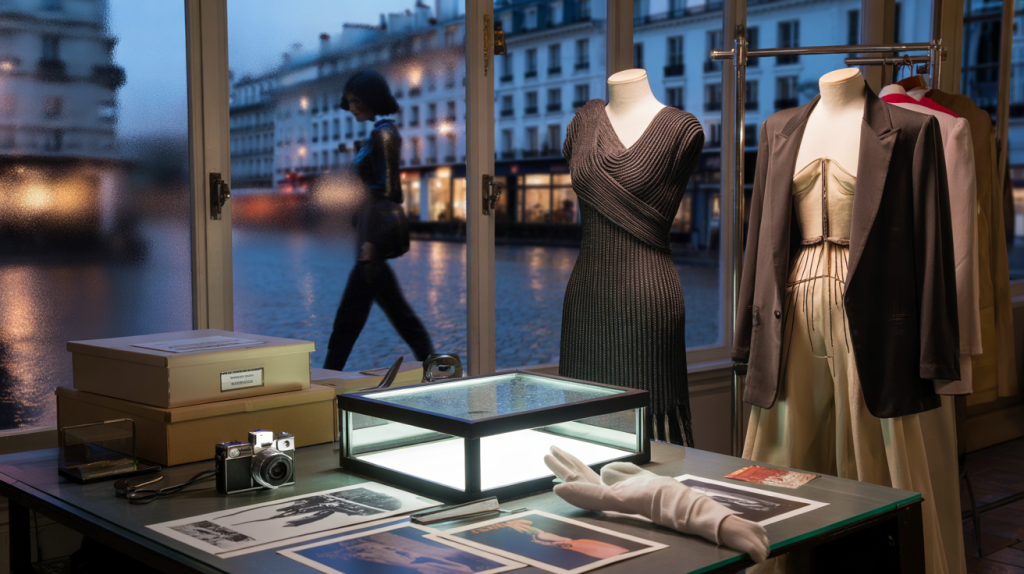Sharp shoulders, a sleek silhouette, Paris by night. Farida Khelfa turned the streets and catwalks of the 1980s into a living studio, alongside Azzedine Alaïa and Jean Paul Gaultier. Those images still fuel today’s mood boards, yet finding the authentic sources is not always simple.
Good news : her trail is visible, and it is rich. From the Fondation Azzedine Alaïa in Paris to public museums and major photo agencies, several institutions safeguard her runway moments, editorial stories and TV appearances. Here is where professionals, students and fashion lovers actually retrieve Farida Khelfa’s fashion archives without drowning in noise.
Farida Khelfa and Azzedine Alaïa : the Paris anchor for archival research
The most tangible starting point sits at 18, rue de la Verrerie, 75004 Paris : the Fondation Azzedine Alaïa. After Azzedine Alaïa’s passing in November 2017, the foundation amplified access to his work through regular exhibitions and careful conservation. Farida Khelfa, a close collaborator since the 1980s, appears across lookbooks, runway photos and behind the scenes materials preserved there.
Why this matters : Alaïa designed and documented obsessively. The foundation’s shows since 2018 have drawn from that deep reservoir, often revealing period images and credits that circulating scans miss. Visiting the space provides context impossible to replicate online, especially for dating an outfit or confirming a photographer’s credit.
Need a cross check in the same neighborhood of sources : Palais Galliera, the City of Paris fashion museum, reopened in 2020 and stewards a collection surpassing 200,000 garments, accessories, photographs and documents. While not a Khelfa specific archive, its research library and exhibitions help date silhouettes and trace magazine features from the late 20th century.
Runways, magazines and Jean Paul Gaultier : tracing the 1980s and 1990s
Farida Khelfa’s image grew in tandem with Jean Paul Gaultier, who founded his house in 1976 and reshaped Paris fashion in the following decade. To map her Gaultier moments, editorial archives are key. Condé Nast’s holdings cover more than 100 years of Vogue and other titles, which means period issues often carry the exact credit lines and publication dates sought by researchers.
Vogue Runway and digitized magazine repositories help place a look within a specific collection season. Cross reference runway sheets with editorials to separate custom pieces from show looks. This reduces misattributions that circulate on social media and resale sites.
For broader context on French fashion media, the Bibliothèque nationale de France and the Palais Galliera library maintain periodicals, designer press kits and show invitations. When a caption feels off, these two reading rooms usually settle the question.
Reliable digital sources : videos, photos and rights at a glance
Television segments and interviews complete the picture. The Institut national de l’audiovisuel, created in 1975, hosts historical TV reports, runway extracts and interviews on its public platform. Clips capture gait, fabric movement and styling details that still photography misses.
For stills, major photo agencies carry searchable archives with detailed metadata. Getty Images’ editorial database counts well over 200 million assets, including catwalks and backstage coverage from Paris fashion weeks. Alamy and Keystone also surface period material from European photographers who followed Khelfa’s circle.
One practical point : licensing. Museum and agency archives usually list usage rights and fees up front. This avoids the trap of reposting uncredited scans that can jeopardize a project. When in doubt, contact the rights department before publication.
How to build your own Farida Khelfa archive : a simple field method
Let the research feel human and iterative. Start with one verified image, then spiral outward to adjacent seasons and collaborators. A small, consistent routine beats a thousand tabs left open. Here is a compact checklist to keep the process clean.
– Begin at Fondation Azzedine Alaïa in Paris for exhibition catalogues and captions, then log the exact dates and credits as your baseline.
– Search INA by person and decade, and note broadcast titles and air dates to triangulate runway seasons.
– On Getty Images and Alamy, filter by location Paris and years 1981 to 1992, then add designer names : Azzedine Alaïa, Jean Paul Gaultier, also photographers like Peter Lindbergh or Paolo Roversi.
– Use magazine indices at Palais Galliera or BnF to confirm editorials and cover stories, and photograph the masthead page for full credits.
– Keep a spreadsheet with fields for date, designer, photographer, publication, source link and licensing status. A filename convention prevents archvies from drifting.
Why this approach still works today : fashion history thrives on precise attribution. Azzedine Alaïa’s foundation stabilizes the garment side. INA and photo agencies stabilize motion and image rights. Museum libraries stabilize the editorial record. Together, they turn a hazy memory of a Paris night into verifiable material ready for a book, a lecture or a mood board. And yes, the thrill remains. It is definitly there when a caption, a date and a dress suddenly click into place.
